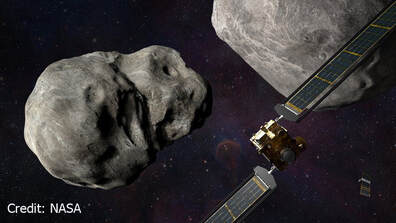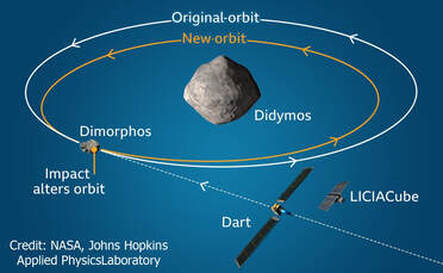|
Graham writes … John and I are offering an additional post in recognition of NASA’s DART mission, which launched recently (24 November 2021). The acronym DART stands for Double Asteroid Redirection Test for reasons which will become apparent. The objective is to crash the spacecraft into a small asteroid to determine the effect the impact has upon the orbit of the asteroid. If all goes well, the impact will occur on 26 September 2022.  So why is NASA deliberately crashing its valuable spacecraft into a lump of rock? The answer to this question goes back some 60 million years, when an asteroid about 10 km across impacted what is now called Central America, creating a global catastrophe which ultimately led to the extinction of the dinosaurs. The impact speed of the object is unknown, but most likely of the order of 10s of kilometres per second, resulting in a hugely energetic event which dwarfs those created by our most powerful nuclear weapons. We discuss this event, and its consequences, in the concluding section of Chapter 5 of the book.  Coming back to the twenty first century, we consider the occurrence of such an event to be very unlikely. However, we also appreciate from consideration of Earth’s history that such catastrophes are inevitable in the future. For example, the 1.1 km diameter Barringer Crater in Arizona, USA was created by the ground impact of a 50 metre diameter asteroid some 50,000 years ago. Also, an air burst of an asteroid in the Tunguska region of Siberia in 1908 flattened forestation over an area about the size of the London M25 orbital motorway. This one was caused by an object about 60 metres across. Clearly, we have to wait a very long time for a 10 km impactor, but the arrival of these smaller objects occurs more frequently, and the devastation that would result if one struck a large city cannot even be imagined. So, we need to take planetary defence, with regard to celestial impactors, seriously. This is why the DART mission was proposed and implemented. The spacecraft is referred to as a ‘kinetic impactor’, and you could say that the process is a bit like a game of celestial billiards. When the spacecraft hits the asteroid, it will change the asteroid’s speed a little, and this small change will alter the asteroid’s orbit. It is effectively a test to see if the orbit of an asteroid, that threatens to impact the Earth in the future, can be changed sufficiently to prevent a catastrophic collision with Earth.
The target asteroid for the test is a 160 metre diameter object called Dimorphos, which itself is in orbit around a larger asteroid (780 metres across) called Didymos – see images. To discuss asteroid impacts in general, and the DART mission in particular, John and I have attempted a ‘vlog’ – that is a video blog which we have posted on YouTube. If you would like to see this please click here. We have not used this medium before, but nevertheless we hope you find it interesting. Please leave thoughts and comments on this website, or on YouTube. Graham Swinerd Southampton December 2021
0 Comments
Leave a Reply. |
AuthorsJohn Bryant and Graham Swinerd comment on biology, physics and faith. Archives
July 2024
Categories |

 RSS Feed
RSS Feed
